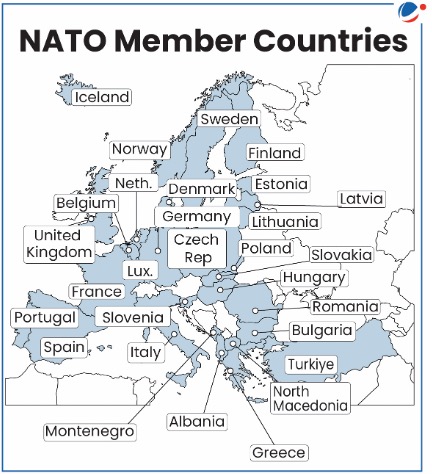Why in the news?
Recently, the North Atlantic Treaty Organization (NATO) marked 75 years of its formation and Sweden has joined NATO as its 32nd member.
About NATO
- Genesis: Founded in 1949, with the signing of the North Atlantic Treaty or Washington Treaty, with the aim of acting as a deterrent to the threat of Soviet expansion in Europe after World War II.
- Headquarters: Brussels (Belgium)
- Nature: NATO is a political and military alliance of 32 countries from Europe and North America.
- It is founded on the principle of collective defence (Article 5 of the Treaty), meaning that if one NATO Ally is attacked, then all NATO Allies are attacked.
- So far, Article 5 has been invoked once – in response to the 9/11 terrorist attacks.
- Founding members (12): Belgium, Canada, Denmark, France, Iceland, Italy, Luxembourg, Netherlands, Norway, Portugal, the United Kingdom and the United States.
- Finland joined NATO in 2023.
- Ukraine formally submitted application to join NATO, in 2022 and it received assurances at Vilnius Summit in 2023.
- EU members that are not a part of NATO are: Austria, Cyprus, Ireland and Malta.

- Purpose: NATO provides a unique link between the Europe and North America (the transatlantic link), enabling them to consult and cooperate in the field of defence and security, and conduct multinational crisis-management operations together.
 Funding: Every NATO country contributes to the costs of running the Alliance, based on a cost-share formula derived from Gross National Income.
Funding: Every NATO country contributes to the costs of running the Alliance, based on a cost-share formula derived from Gross National Income. - NATO Partnerships: NATO maintains relations with more than 40 non-member countries and international organisations, called NATO partners, through following structures:
- Partnership for Peace(PfP): A programme of bilateral cooperation with countries in Euro-Atlantic area. It include 18 partner countries, including Russia (partnerships with Belarus and Russia are currently suspended).
- Mediterranean Dialogue(MD), for countries in the Mediterranean region.
- Istanbul Cooperation Initiative (ICI) for countries in the Middle East region.
- International organisations: NATO cooperates with UN, EU and Organization for Security and Co-operation in Europe (OSCE)
- 2022 Strategic Concepts: Adopted by NATO in its 2022 summit, it is a guiding document which reflects the emerging security reality.
- It identifies Russia as the most significant and direct threat to Allied security,
- Addresses China for the first time for encroaching on European interests and
- Includes other challenges like terrorism, cyber and hybrid threats, maritime security etc.
Key achievements of NATO
|
Story of NATO’s Expansion in Eastern Europe
- The Soviet Union responded to NATO by creating its own military alliance with seven other Eastern European communist states in 1955, dubbed the Warsaw Pact.
- But after the collapse of the Soviet Union in 1991, a number of former Warsaw Pact countries became NATO members. This includes Hungary, Poland, Bulgaria, Estonia, Latvia among others.
- NATO's Open door policy (Article 10), allows any European country that can enhance and contribute "to the security of the North Atlantic area" to join.
Implications of East ward expansion of NATO
- Creating mistrust between Russia and West: Expansion is seen as an aggressive act by Russia that threatens to undo decades of security cooperation and tilt Russia closer toward considering an anti-Western alliance with China and Iran.
- Reverse trend of demilitarisation in region: New NATO members would need to devote enormous funds to integrate with the Western command structure thereby diverting money from the productive sectors to military spending.
- Sharpening existing divisions in Europe: By admitting certain countries before others, NATO would sharpen already existing divisions in the region–between more prosperous North and the less prosperous South, between Eastern Europe and countries of former Soviet Union.
- Increased Militarization in Europe: Russia views NATO's expansion in Europe as a destabilizing factor. This perception has led to significant opposition from Russia, including the possibility of military intervention, as evidenced by its actions in Georgia and ongoing tensions in Ukraine.
Major challenges faced by NATO
- Funding Issues: In 2006, NATO Defense Ministers agreed to a commitment that 2% of their countries’ GDP would be allocated towards defence spending. However, the majority of NATO members do not meet this goal.
- Right-Wing Nationalism: With the spread of right-wing nationalism across Europe, discontent with international institutions like NATO and the EU is growing.
- US’ commitment to Europe’s defence: Former US President questioned value of the alliance and whether US should honour the Article 5 commitment.
- Russian Aggression: NATO's admission of several members since the fall of the Soviet Union, despite verbal assurances to Russia regarding no eastern expansion undermines trust between NATO and Russia, fuelling tensions and perceptions of aggression.
- Rise of China: Chinese expanding military posture in the Indo-Pacific; an economic and technological footprint that threatens Europe’s own industrial and technological base pose a challenge to NATO.
Conclusion
Embracing a comprehensive strategy of innovation, resilience-building, and strategic foresight will be imperative for NATO to navigate complex geopolitical realities and sustain its role as a pillar of international security and stability.
Other related terms
|








